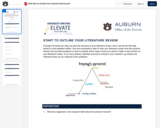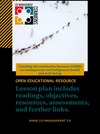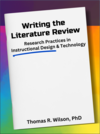
This worksheet helps you analyze an example literature review to identify the storytelling elements being used.
- Subject:
- Composition and Rhetoric
- English Language Arts
- Material Type:
- Activity/Lab
- Provider:
- Auburn University
- Date Added:
- 10/12/2022

This worksheet helps you analyze an example literature review to identify the storytelling elements being used.

This freshman course explores the scientific publication cycle, primary vs. secondary sources, and online and in-print bibliographic databases; how to search, find, evaluate, and cite information; indexing and abstracting; using special resources (e.g. patents) and “grey literature” (e.g. technical reports and conference proceedings); conducting Web searches; and constructing literature reviews.

Introduction to Sociology 2e adheres to the scope and sequence of a typical, one-semester introductory sociology course. It offers comprehensive coverage of core concepts, foundational scholars, and emerging theories, which are supported by a wealth of engaging learning materials. The textbook presents detailed section reviews with rich questions, discussions that help students apply their knowledge, and features that draw learners into the discipline in meaningful ways. The second edition retains the book’s conceptual organization, aligning to most courses, and has been significantly updated to reflect the latest research and provide examples most relevant to today’s students. In order to help instructors transition to the revised version, the 2e changes are described within the preface.


Define and describe the scientific methodExplain how the scientific method is used in sociological researchUnderstand the function and importance of an interpretive frameworkDefine what reliability and validity mean in a research study

This resource is a video abstract of a research paper created by Research Square on behalf of its authors. It provides a synopsis that's easy to understand, and can be used to introduce the topics it covers to students, researchers, and the general public. The video's transcript is also provided in full, with a portion provided below for preview:
"No pregnant woman wants to hear that her developing baby has a life-threatening genetic disease. Historically, women carrying babies with alpha thalassemia major, a type of hereditary anemia, faced the difficult choice between terminating a pregnancy or continuing on despite nearly assured fetal death. Now, researchers at UCSF have reported another option: in utero blood transfusion, or IUT. In this procedure, healthy red blood cells are infused into the fetus, which can reverse the effects of ATM and increase the chance of survival. Fetal hemoglobin – a protein with two alpha and two gamma subunits – is the main oxygen supplier in utero. Patients with ATM lack alpha subunits. As a result, their hemoglobin holds oxygen so tightly that it cannot be released into developing tissues. While a lack of oxygen is harmful at any age, the effects in utero are particularly severe – depriving a developing brain of oxygen, for example, can cause devastating neurologic injury..."
The rest of the transcript, along with a link to the research itself, is available on the resource itself.

This literature review explores the use of technology and the pedagogy behind implementing digital portfolios.

This document defines a literature review, outlines its purpose and what it demonstrates. The steps to undertaking a literature review are specified, and links to more information are included for Murdoch University.

This resource is a video abstract of a research paper created by Research Square on behalf of its authors. It provides a synopsis that's easy to understand, and can be used to introduce the topics it covers to students, researchers, and the general public. The video's transcript is also provided in full, with a portion provided below for preview:
"When it comes to immune functioning, cancers and autoimmune diseases are opposites. The key immune-related defect in cancer is subverting and evading the immune system, while autoimmune disease is, broadly speaking, an overactive immune system targeting the self. The immune system and the gut microbial community have a reciprocal influence on each other. Therefore, it is possible that cancers and autoimmune diseases have analogous but inverted impacts on the gut microbiome. To test this, researchers conducted a systematic literature review. The included studies covered over 10,000 people from 27 countries. This data revealed a set of microbiome features that show consistent, opposite changes in cancers compared to autoimmune diseases. Fusobacterium and Peptostreptococcus were the most consistently increased bacterial genera in cancer cases. While Bacteroides stood out as a group increased in autoimmune disease and decreased in cancers..."
The rest of the transcript, along with a link to the research itself, is available on the resource itself.

This resource is a video abstract of a research paper created by Research Square on behalf of its authors. It provides a synopsis that's easy to understand, and can be used to introduce the topics it covers to students, researchers, and the general public. The video's transcript is also provided in full, with a portion provided below for preview:
"The human protein Tid-1 sits at the nexus of many key cellular processes and signaling pathways. These processes include cellular proliferation, growth, survival, aging, apoptosis, and even movement. Tid-1 is a member of the heat shock protein 40 family and helps other proteins fold correctly after translation or refold after a damaging stress event. Dysregulated Tid-1 behavior is involved in numerous human diseases including cancers, cardiomyopathies, and neurodegenerative disorders. Given its wide influence within the cell, Tid-1 could be a key biomarker or even therapeutic target for these diseases, but to leverage Tid-1 effectively, researchers need to understand its functionality in detail. To this end, a team of scientists consolidated the current research on human Tid-1. They found that Tid-1’s protein-protein interactions corresponded to its roles in various diseases and provide insight into how Tid-1 affects pathogenic developments..."
The rest of the transcript, along with a link to the research itself, is available on the resource itself.

It is expected that Students who take part in this course have completed almost all courses of their MSc and are about to start on their Master Orientation project, their Literature Study or MSc thesis depending on their chosen MSC track.
It is of little value to take this course early, so please plan accordingly!
Course Contents The aim of the course is to be a research-driven preparation for the aerospace engineering MSc thesis in the final year of the MSc. It will help you prepare for the challenges of your thesis work.
The course will consist of 7 lectures and will be taught online using video lectures in periods 1, 2 and 3 and face-to-face using traditional lectures in period 4.
The lecture set up is as follows:
1. Research Design in MSc - Introduction to research, research framework
2. Research Methods - Stages of a project, Research objective, research questions, research strategy, research methods
3. Data Analysis - Quantitative & Qualitative methods
4. Validation & Verification - How to validate & verify your work?
5. Project Management & Peer review of draft Project plan - How to manage your project and your thesis progress. Project plan peer review
6. Planning - How to plan, expectations, Gannt Charts
7. Literature Review - How to carry out a scientific literature review? Differences between review and research
Please be advised that all lectures are also available via Blackboard for those following the online version. It is possible to do this course by distant learning, attendance in the 4th period, though highly appreciated, is not mandatory!
Study Goals At the end of the course the student will:
- be aware of the expectations of an MSc student
- be able to formulate a research question and research aim
- be able to set up a research plan for their MOP/Literature Study/MSc thesis
- be able to write a literature review based on the research plan with a view to select appropriate methodologies for their MOP/MSc thesis
Education Method (Online) Lectures, Assignments and voluntary Peer review of each others research plans and literature studies

This worksheet parallels the moves a writer makes when creating a literature review with Freytag’s pyramid. It guides writers in outlining their own literature reviews by answering a series of brainstorming questions.

These open-access journal articles provide qualitative evidence showing the connections between Indigenous health and well-being and wildlife co-management. A lesson plan is also provided for potential professors or co-management board practitioners wishing to study independently.

Students of instructional design now have their own guide for writing a literature review in their graduate programs. Focused on the unique requirements of IDT research, this user-friendly text provides step-by-step instructions for planning, researching, and writing a quality literature review. Based on adult learning principles, this book delivers strategies that students will take with them into their careers as instructional designers. This is the actual text that the author uses in his graduate-level, IDT research courses, and now his strategies are available for other educators to adapt and use for their students.